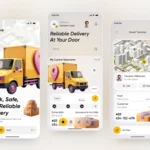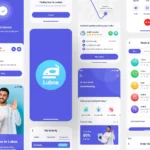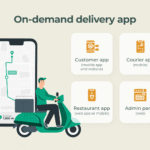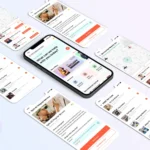Introduction: The Rise of On-Demand Mobility
The on-demand economy has changed how people travel, connect, and use daily services. Among these, taxi booking apps are still one of the most popular because they make rides easy, quick, and safe.
According to Market.us, the global taxi app market was valued at USD 238.1 billion in 2023 and is expected to reach USD 468.4 billion by 2033, growing at a rate of about 7 percent every year. This growth is mainly because more people now use smartphones, prefer online payments, and look for faster travel options in cities.
For new startups and existing companies, creating a taxi booking app is not just about building another transport app. It is about making travel more simple, reliable, and connected for users and drivers.
This blog will help you understand how taxi booking apps work, what features they include, how much they cost to develop, and how to plan a smart strategy before launch.
Market Overview: Growth, Trends, and Future Scope
The global taxi booking market is growing as more people switch to app-based rides for comfort, safety, and transparent pricing. Rising smartphone use and online payment options are helping this shift worldwide.
Key Market Insights
According to IMARC Group, the global taxi market was worth USD 244.02 billion in 2024 and is expected to reach USD 368.40 billion by 2033, with a yearly growth rate of 4.66 percent.
Allied Market Research notes that the global ride-hailing industry is projected to reach USD 432 billion by 2032, supported by the growing use of electric and hybrid vehicles.
Mordor Intelligence highlights a major shift toward multi-service apps, where users can book taxis, bikes, or delivery services from one platform.
Fortune Business Insights adds that Asia-Pacific is the fastest-growing region due to digital wallets, affordable smartphones, and rising urban travel demand.
These facts show that the future of taxi booking apps will focus on flexibility, safety, and connected services, giving both startups and transport companies a big chance to grow globally.
How Taxi Booking Apps Work
Taxi booking apps connect passengers and drivers in real time through a simple digital system. The process includes three main parts, the Passenger App, Driver App, and Admin Panel each designed to make rides smoother and faster for everyone.
1. Passenger App Workflow
Users create an account, enter pickup and drop locations, and confirm the ride request.
The system automatically matches them with nearby drivers based on distance and availability.
Passengers can track the driver’s location, view fare details, and pay securely using digital methods.
A report from Research Nester shows that features like real-time tracking and cashless payments have increased user retention by more than 30 percent in ride-booking apps.
2. Driver App Workflow
Drivers receive ride requests, accept bookings, and navigate through built-in GPS guidance.
They can manage ride history, earnings, and performance ratings in one dashboard.
As noted by Dataintelo, driver satisfaction improves when apps include transparent payment tracking and incentive programs.
3. Admin Panel Workflow
Admins monitor all rides, users, and payments in real time to ensure smooth operations.
They can adjust fares, manage drivers, and handle customer support.
According to 360iResearch, a strong admin panel helps companies reduce operational errors by nearly 40 percent through automation and analytics.
These three layers work together to create a seamless system that benefits passengers, drivers, and service providers alike. The smoother the process, the better the user experience and long-term growth potential for the platform.
Types of Taxi Booking Models
Before starting development, it is important to understand the different types of taxi-booking business models. Each model has its own benefits and challenges based on how rides are managed and how revenue is earned.
1. Aggregator Model
This is the most common model used by global leaders such as Uber and Bolt.
The company builds a platform that connects passengers with independent drivers.
The platform earns through commissions and surge pricing on each trip.
According to Precedence Research, aggregator platforms generated over USD 155 billion in revenue in 2023, making them the largest segment in ride-hailing.
It offers easy market entry and faster scalability for startups.
2. Fleet-Owned Model
In this model, the company owns and manages all vehicles and drivers directly.
Suitable for businesses that want full control over operations and quality.
Offers predictable pricing, brand consistency, and better maintenance control.
A report by Straits Research notes that corporate and luxury taxi services prefer this model for premium user experience.
Requires higher initial investment and operational management.
3. Peer-to-Peer (P2P) Model
This model connects individual car owners with riders through a verified community platform.
Ideal for regions with high personal car ownership but limited public transport.
Drivers can use their own cars and earn part-time income.
According to The Business Research Company, peer-to-peer ride-sharing is expected to grow at over 10 percent CAGR between 2024 and 2028.
Helps build community-driven mobility networks at a lower cost.
Each model has its strengths. Aggregator models scale quickly, fleet-owned models maintain strong control, and peer-to-peer models encourage flexibility and local trust. Startups often choose a hybrid model that blends all three for better coverage and user satisfaction.
Features You Can’t Ignore
Core and Advanced Features of a Taxi Booking App
Building a strong taxi booking app means combining essential features with smart, future-ready upgrades. These features make the platform easy to use, scalable, and trusted by both passengers and drivers.
1. Passenger App Features
Essential and advanced features that improve the overall rider experience.
Quick Signup and Login: Options for mobile number, email, or social media.
Live Ride Tracking: Real-time map view and driver status updates.
Fare Estimation: Instant price preview before confirming the ride.
Multiple Payment Methods: Cash, credit/debit card, wallet, and UPI options.
Ride Scheduling: Book rides for a future date or time.
Save Favorite Locations: For faster booking of regular routes.
Split Fare Option: Share payment with co-passengers.
SOS and Safety Alerts: Emergency contact and panic button features.
Ride History and Digital Receipts: View and download all past trips.
In-App Chat and Call: Communicate with drivers securely without sharing phone numbers.
Loyalty Points and Rewards: Encourage repeat bookings.
Voice Booking: Book rides using voice commands.
Multi-Language Support: App available in multiple regional languages.
Gender Preference Option: Female passengers can choose women drivers (as offered by Careem and inDrive).
Ride Rating and Feedback System: Helps improve service quality.
According to Verified Market Reports, adding personalized feedback and loyalty rewards increases customer retention by 35 percent.
2. Driver App Features
Features that help drivers work efficiently and earn more.
Instant Ride Notifications: Alerts with pickup details and distance.
Navigation and Route Optimization: Built-in GPS with live traffic updates.
Earnings Dashboard: Shows completed trips, earnings, and incentives.
Driver Availability Control: Switch between online/offline modes easily.
Heat Maps: Shows high-demand areas to maximize bookings.
Trip Acceptance and Cancellation Control: Drivers can manage their ride preferences.
Fuel Cost Calculator: Helps track estimated expenses.
Driver Ratings and Feedback: Encourage better performance.
In-App Wallet: Manage earnings, bonuses, and withdrawals.
Support Chat: Contact support directly for issues or updates.
A report from Data Bridge Market Research found that apps with driver reward systems improve engagement by 28 percent.
3. Admin Panel Features
Tools that help companies monitor, optimize, and grow operations.
User and Driver Management: Approve profiles, update records, and track performance.
Trip Analytics and Reports: Real-time ride insights by city, distance, or time.
Pricing and Surge Control: Adjust fares dynamically based on demand.
Promo and Discount Management: Create and track offers easily.
Dispute and Complaint Handling: Manage passenger-driver conflicts.
Multi-City or Multi-Country Control: Centralized control for scaling businesses globally.
Automated Tax and Commission Reports: Simplify accounting and payouts.
As per Maximize Market Research, advanced analytics dashboards reduce support load by 40 percent and increase efficiency by 25 percent.
4. Future-Ready and Trending Features (2025 and Beyond)
Emerging technologies shaping the next generation of taxi booking apps.
AI-Based Demand Prediction: Suggests drivers to busy areas automatically.
Smartwatch App Integration: Book rides directly from wearables.
Electric Vehicle (EV) Mode: Shows EV-only drivers for eco-friendly rides.
Carpool and Shared Ride Matching: Saves cost and reduces traffic.
Subscription Plans for Users: Monthly ride packages for frequent travelers.
Autonomous Vehicle Integration: Prepare for driverless fleet compatibility.
In-App Ads and Brand Partnerships: Extra monetization for app owners.
Facial Recognition Login: Improves security for both users and drivers.
Carbon Footprint Tracker: Displays how much CO₂ is saved per ride.
Dark Mode and Accessibility Settings: Modern UI trends improving usability.
Fortune Business Insights notes that EV adoption and green ride options are among the top growth drivers for taxi apps in 2026.
Together, these features make your taxi booking app competitive and future-proof. The goal is to balance simplicity for users, flexibility for drivers, and control for business owners.
Technology Stack and Development Architecture
Choosing the right technology stack is one of the most important steps in taxi booking app development. It decides how fast the app runs, how easily it scales, and how safe it is for users and drivers.
1. Mobile App Development
Android: Java or Kotlin are used for native Android apps.
iOS: Swift is the best choice for native iPhone apps.
Cross-Platform: Frameworks like Flutter and React Native help build one app that runs smoothly on both Android and iOS.
Statista reports that Flutter is one of the most widely used cross-platform tools among developers in 2026.
2. Backend Development
The backend is the main system that connects passengers, drivers, and admin panels in real time.
Popular Languages: Node.js, Laravel (PHP), or Python.
Database Management: MySQL, PostgreSQL, or MongoDB for storing ride data, payments, and user profiles.
Server Hosting: AWS, Google Cloud, or Azure for stability and quick scaling.
According to BuiltWith, AWS continues to be the most popular cloud platform for ride-hailing apps because of its global reach and uptime reliability.
3. Maps and Navigation
A taxi app depends heavily on location tracking and route optimization.
Mapping APIs: Google Maps, Mapbox, or OpenStreetMap for real-time directions.
Distance Calculation: GPS integration for accurate fare estimates.
Live Traffic Data: Helps drivers find faster routes and avoid congestion.
Mapbox confirms that 70 percent of on-demand mobility startups now use map APIs for real-time driver tracking.
4. Payment Gateways and Security
Safe and easy payments are a must for trust and smooth operation.
Payment APIs: Stripe, PayPal, Razorpay, and Braintree are popular choices.
Security Measures: SSL encryption and OTP verification keep transactions safe.
Digital Wallets: Allow riders to store balance for quick payments.
As per Grand View Research, digital wallet payments are projected to handle more than 60 percent of in-app transactions by 2026.
5. Push Notifications and Communication
To keep users and drivers informed in real time.
Push Notifications: Firebase Cloud Messaging (FCM) or OneSignal.
In-App Chat or Call: Twilio or SendBird for secure, masked communication.
SMS Integration: Nexmo or Plivo for ride updates and OTPs.
6. Admin Panel Tools
For web-based monitoring and analytics.
Frontend Framework: React.js or Vue.js for dashboards.
Analytics Tools: Google Analytics, Mixpanel, or Firebase Analytics for usage tracking.
Automation Tools: Zapier or n8n for automating reports and alerts.
Gartner reports that low-code and no-code dashboards are helping companies reduce operational setup time by up to 45 percent.
7. Architecture Setup
A smooth taxi booking app runs on a three-layer architecture:
Presentation Layer: User interface (passenger and driver apps).
Business Logic Layer: Handles ride matching, payments, and surge pricing.
Database Layer: Stores all user, trip, and payment details securely.
This structure ensures your app stays fast, secure, and scalable even as user numbers grow.
Choosing the right tools from the start saves cost, reduces maintenance, and ensures long-term success. The key is to pick a stack that balances speed, security, and flexibility for both Android and iOS users.
Taxi Booking App Development Cost in 2026
Building a taxi booking app in 2026 requires careful planning of cost and resources. The total cost depends on the app’s design, features, team structure, and target market. Understanding these factors early helps avoid surprises later.
1. Main Cost Factors
App Complexity: More features like live tracking, wallets, or multi-language support increase development time.
Platforms: Building for both Android and iOS costs more than a single platform.
Design Quality: Custom UI/UX designs cost more but attract better user retention.
Technology Stack: The choice of backend, cloud services, and APIs also affects cost.
Team Size and Location: Hiring experienced developers or agencies in different regions changes overall pricing.
GoodFirms notes that app development cost mainly varies with complexity, taking anywhere from 500 to 1,200 hours for medium-sized projects.
2. Estimated Cost by Complexity
App Type | Key Features | Estimated Cost Range (USD) |
|---|---|---|
Basic App | Login, ride booking, payment, tracking | $20,000 – $35,000 |
Mid-Level App | Multiple payment options, ratings, scheduling | $35,000 – $60,000 |
Advanced App | Loyalty programs, voice booking, multi-language, admin dashboard | $60,000 – $100,000+ |
According to Clutch, the average hourly rate for professional app developers ranges between $25 to $120, depending on region and expertise.
3. Regional Development Cost Comparison
Region | Average Hourly Rate | Typical Total Cost |
|---|---|---|
North America (USA/Canada) | $80 – $150/hr | $80,000 – $150,000 |
Western Europe (UK/Germany) | $60 – $120/hr | $60,000 – $110,000 |
Eastern Europe (Poland/Ukraine) | $40 – $70/hr | $40,000 – $75,000 |
Asia (India/Philippines) | $20 – $50/hr | $20,000 – $55,000 |
Business of Apps confirms that Asia remains a strong region for startups due to skilled talent and competitive pricing.
4. Hidden or Additional Costs
App store registration and annual renewal fees.
Ongoing server hosting and maintenance.
Marketing and user acquisition after launch.
Post-launch bug fixing and feature updates.
Customer support and admin staffing.
Statista reports that about 40 percent of total app spending goes into maintenance and post-launch improvements.
5. Cost-Saving Tips for Startups
Start with a Minimum Viable Product (MVP) to test features early.
Use cross-platform tools like Flutter to save development hours.
Choose cloud hosting with auto-scaling to avoid unused server costs.
Hire a dedicated offshore team for long-term engagement instead of freelancers.
Reuse open-source modules for basic functions like maps or payments.
On average, building a taxi booking app in 2026 will cost between $35,000 and $80,000, depending on scale and feature depth. Planning a staged rollout, MVP first, then upgrades — is the best way to control cost while testing the market.
Monetization Models and Revenue Streams
Building a taxi booking app is not only about rides and features. The real goal is to create a system that earns regular income and grows with user demand. Below are the most common and proven ways these apps generate revenue.
1. Commission-Based Model
This is the most popular and widely used method by global apps like Uber, Bolt, and Ola.
The company takes a percentage of every completed ride.
The rest of the fare goes to the driver after deducting taxes or platform fees.
According to Fortune Business Insights, commission-based taxi platforms account for more than 70 percent of total market revenue worldwide.
2. Surge Pricing (Dynamic Fare System)
Prices increase automatically during high-demand hours or bad weather.
This model helps maintain driver availability when requests are high.
Allied Market Research states that surge pricing can boost app revenue by 15–20 percent during peak times.
3. Subscription or Membership Plans
Users can pay a monthly fee for discounted rides, priority bookings, or zero surge charges.
Drivers can also subscribe for lower commission rates or premium visibility on the app.
The Business Research Company reports that subscription-based features have become a key growth strategy for ride-hailing platforms in 2026.
4. In-App Advertising and Brand Partnerships
Local businesses, restaurants, and delivery brands can advertise inside the app.
Ads are shown on ride confirmation screens or driver dashboards.
IMARC Group notes that in-app advertising now contributes 8–10 percent of total platform revenue for leading mobility apps.
5. Corporate Accounts and B2B Services
Companies can book rides for employees through a central business account.
These clients usually pay monthly invoices instead of per-ride payments.
Grand View Research highlights that corporate ride services are expected to grow at over 12 percent CAGR through 2030.
6. Car Leasing and Rental Partnerships
The platform can lease vehicles to drivers who do not own a car.
This model ensures driver supply while generating recurring revenue.
A report by Mordor Intelligence predicts steady growth in the driver leasing model due to flexible earning options.
7. Cancellation and Service Fees
When passengers cancel after booking, a small fee helps compensate drivers.
Similarly, late-night or premium rides can include service charges.
Precedence Research shows that apps using structured service fees maintain 10 percent higher profitability margins.
8. Data Analytics and Marketplace Insights
Apps can offer anonymized trip data to city planners or transport authorities for better route management.
This helps generate an extra income stream while improving traffic management.
TechTarget explains that data sharing is becoming part of the mobility-as-a-service (MaaS) model in smart cities.
Modern taxi apps often combine two or more of these revenue streams. For startups, the best approach is to start with commissions and surge pricing, then expand into subscriptions, corporate rides, and in-app ads as the user base grows.
Compliance, Safety, and Data Security
A successful taxi booking app must build trust among passengers, drivers, and local authorities. To do this, it needs strong safety measures, clear legal compliance, and reliable data protection. These factors not only prevent risks but also help build long-term customer loyalty.
1. Driver Verification and Background Checks
Every driver should go through identity verification and police background screening.
Required documents include driver’s license, vehicle registration, and insurance proof.
Some companies also use facial recognition to confirm driver identity before starting a trip.
According to Business of Apps, strict driver screening has improved rider satisfaction by over 25 percent in top ride-hailing apps.
2. Real-Time Tracking and Emergency Features
Live GPS tracking lets both riders and admins monitor each trip safely.
SOS or emergency buttons help passengers share their live location with family or authorities.
Instant alerts can also be sent if a ride stops unexpectedly or takes a long route.
Safety Detectives notes that ride apps with emergency tracking and panic features build stronger user confidence and reduce safety incidents.
3. Insurance and Legal Compliance
The app should cover both passenger and driver under insurance for accidents or unexpected issues.
Local transport laws and regional licenses must be followed before launching operations.
Compliance with country-specific laws (like the Motor Vehicles Act in India or the TNC laws in the USA) avoids penalties and ensures smooth operations.
PwC Global Mobility Report highlights that legal readiness is one of the top challenges for new mobility startups.
4. Data Privacy and Security
Passenger data, location history, and payment details must be stored securely.
Use of SSL certificates, OTP verification, and encryption is essential.
Apps must comply with privacy laws like GDPR (Europe) and CCPA (California).
IBM Security reports that the average cost of a data breach in transportation apps reached USD 4.9 million in 2023, proving why security is non-negotiable.
5. Fraud Detection and Account Protection
Automated fraud systems detect fake accounts, suspicious ride activity, or payment fraud.
OTP-based login and two-step verification prevent unauthorized access.
Cybersecurity Ventures forecasts that global cybercrime damages could exceed USD 10 trillion by 2026, making preventive steps a top priority for app owners.
Strong compliance and security policies protect not only passengers but also the brand reputation of your app. In a competitive market, users are more likely to choose a platform that promises transparency, privacy, and genuine safety over lower prices or flashy features.
Design and User Experience (UX) Best Practices
The design of a taxi booking app plays a big role in how users feel while booking a ride. A clean interface, quick access to features, and clear visuals help build trust and encourage repeat bookings. Good UX design can turn a first-time user into a loyal customer.
1. Keep the Interface Clean and Simple
Use large, clear buttons for booking, payments, and navigation.
Avoid unnecessary steps that make the process longer.
Display key information like driver details, fare, and estimated time of arrival upfront.
Adobe Experience Cloud explains that simple layouts reduce bounce rates by up to 40 percent.
2. Focus on Fast Navigation
Users should be able to book a ride in three to four taps.
Add auto-suggestions for pickup and drop locations using recent ride history.
Include a quick “Book Again” button for frequent routes.
Nielsen Norman Group notes that fewer clicks improve conversion and task completion time by 35 percent.
3. Use Visual Clarity and Color Psychology
Use soft background colors with bright call-to-action buttons.
Choose color codes that match your brand but remain easy on the eyes.
Use icons and illustrations instead of text wherever possible.
HubSpot reports that well-chosen color combinations can increase brand recognition by 80 percent.
4. Prioritize Accessibility
Include larger fonts, high contrast themes, and dark mode for night users.
Add voice commands and screen reader support for visually impaired users.
Localize your app in multiple languages for wider reach.
W3C Web Accessibility Initiative states that accessibility-friendly apps attract 20 percent more user engagement across all age groups.
5. Create a Smooth Driver Experience
Keep the driver dashboard simple with earnings, rides, and ratings in one view.
Use route optimization to help drivers save time and fuel.
Avoid flashy animations or complex layouts that may distract during driving.
UX Planet highlights that driver-focused simplicity improves task accuracy and safety during rides.
6. Personalization and User Feedback
Allow users to save favorite drivers or preferred ride types.
Use past behavior to suggest ride packages or rewards.
Collect feedback after every trip and act on it quickly.
Forrester Research found that apps using personalized recommendations improve retention by over 25 percent.
7. Test and Update Regularly
Run usability tests with real users to spot confusing screens.
Keep updating the design based on feedback and analytics.
Track ride completion time, app open rates, and booking conversion to improve flow.
InVision emphasizes that regular UX testing increases customer satisfaction scores by 33 percent.
A well-designed taxi booking app should feel effortless from the first tap to the final payment. When the interface looks modern and functions smoothly, it builds trust — which is the most valuable asset in the mobility business.
Go-To-Market and Launch Strategy
Building the app is only half the journey. The real success starts when your product reaches users. A clear go-to-market strategy helps you launch effectively, attract early riders and drivers, and grow your app step by step.
1. Define Your Target Market
Start with one city or region instead of launching everywhere at once.
Research traffic issues, transport demand, and local ride costs.
Focus on users who often travel short distances or commute daily.
Statista reports that localized launches lead to 35 percent faster adoption in the ride-hailing sector.
2. Validate the Business Model
Test the app as an MVP (Minimum Viable Product) with limited features and routes.
Collect user feedback before scaling up.
Adjust pricing, commissions, or driver incentives based on data.
Harvard Business Review notes that testing assumptions early reduces failure chances by more than half.
3. Driver Acquisition and Onboarding
Offer sign-up bonuses or lower commissions to attract drivers in the beginning.
Create an easy driver registration and training process.
Run local campaigns explaining how the platform helps them earn more.
TechCrunch highlights that flexible payouts and driver rewards improve retention by 30 percent.
4. Passenger Acquisition and Retention
Use promo codes, referral bonuses, or first-ride discounts to encourage app installs.
Partner with local businesses, cafes, or universities for visibility.
Run social media ads with testimonials and real user stories.
Business of Apps reports that referral programs can increase new user acquisition by up to 25 percent.
5. Build Strategic Partnerships
Partner with fuel companies, parking providers, or EV charging networks.
Collaborate with corporate offices for employee transport.
Join hands with government programs promoting smart and sustainable mobility.
McKinsey & Company highlights that strategic partnerships help new mobility startups scale faster and gain city-level trust.
6. Marketing and Public Relations
Run location-based digital ads focusing on convenience and safety.
Create a local influencer campaign showing real app experiences.
Build press kits and share launch stories with online news platforms.
Sprout Social found that local video content on social media increases app engagement by 48 percent.
7. Measure, Analyze, and Improve
Track daily app downloads, bookings, and average user ratings.
Use analytics tools like Google Analytics or Firebase to monitor real-time performance.
Gather feedback from both drivers and passengers every month.
Forbes confirms that data-driven product updates lead to 3x higher long-term growth for mobility startups.
8. Post-Launch Support and Updates
Provide 24/7 support for ride or payment issues.
Regularly fix bugs and update new features based on user behavior.
Stay compliant with transport and data laws in every operating region.
A report by App Annie shows that apps updated every month maintain 60 percent better retention than those updated less frequently.
Launching smart, scaling slow, and learning fast is the key to long-term success. A well-planned go-to-market strategy not only brings users but also helps your app earn trust which is what keeps it growing even in a competitive market.
Future of Taxi Apps: Trends and Innovations
The taxi booking industry is entering a new phase. As more cities move toward smart mobility and sustainable transport, apps are becoming more than just ride-hailing tools. They are turning into complete mobility platforms that connect people, vehicles, and cities efficiently.
1. Electric Vehicle (EV) Integration
More taxi companies are switching to electric cars to reduce fuel costs and emissions.
Governments are offering tax benefits and charging station support for EV fleets.
According to Allied Market Research, the global EV market is expected to reach USD 693 billion by 2030, with growing adoption in the taxi sector.
2. AI-Powered Ride Matching and Demand Prediction
Apps are now using predictive systems to match drivers with nearby passengers faster.
These systems help reduce waiting time and balance demand across busy areas.
Fortune Business Insights states that intelligent route prediction and driver allocation have improved trip efficiency by 25 percent for large taxi operators.
3. Multi-Service Super Apps
Future taxi apps will combine multiple services like ride-hailing, food delivery, parcel shipping, and carpooling in one platform.
This helps companies increase usage frequency and customer lifetime value.
TechCrunch reports that super apps in Asia already manage over 50 percent of total mobility transactions in major cities.
4. Sustainability and Green Mobility
Many taxi apps are adding eco-mode options where users can choose electric or hybrid rides.
Carbon tracking shows users how much CO₂ they save per trip.
Statista notes that eco-focused ride options could reduce global transport emissions by over 12 percent by 2030.
5. Autonomous and Driverless Taxis
Self-driving taxi projects are being tested in cities like San Francisco, Dubai, and Tokyo.
While still limited, they show how automation could change the ride-hailing model completely.
McKinsey & Company predicts that autonomous ride services could become a USD 300 billion market by 2035.
6. Blockchain for Payments and Verification
Blockchain helps verify transactions, reduce fraud, and speed up driver payouts.
It also allows users to track data transparently, which builds trust.
Deloitte confirms that blockchain-based payments are gaining traction in global mobility apps.
7. Augmented Reality (AR) for Navigation
AR is helping drivers visualize routes more accurately and avoid traffic delays.
It can display pick-up zones and drop-off points on the camera view in real time.
Gartner lists AR navigation as one of the top mobile innovations transforming urban mobility.
8. Subscription-Based and Shared Mobility
Users prefer flexible monthly ride plans instead of paying per trip.
Shared rides, bike taxis, and micro-mobility add more options for everyday commuting.
Precedence Research shows that shared and subscription mobility models will grow at a 15 percent CAGR between 2024 and 2032.
9. Data Privacy and Personalization
Future apps will focus on secure, permission-based personalization instead of broad tracking.
Users will control how their location and ride history data are used.
IBM Security reports that improving data privacy can increase user trust and retention by up to 30 percent.
The future of taxi booking apps lies in flexibility, safety, and sustainability. Companies that embrace electric mobility, smart data use, and transparent user experience will lead the next era of on-demand transportation.
Case Studies and Industry Benchmarks
Studying how leading taxi apps grew helps new businesses understand what works and what does not. Each successful company started small but focused on solving one core problem — making urban travel simpler, faster, and safer.
1. Uber: The Global Benchmark for Scalability
Uber began in 2010 as a small ride-sharing app in San Francisco.
Its success came from offering real-time GPS tracking, cashless payments, and surge pricing, which balanced demand and supply.
The company expanded to over 70 countries by partnering with local governments and payment providers.
Business of Apps reports that Uber completed more than 9.4 billion trips in 2023 and remains the global leader in ride-hailing.
Lesson: Focus on technology that simplifies both user and driver experiences before rapid expansion.
2. Careem: Regional Growth Through Localization
Careem, founded in Dubai in 2012, became a regional leader by tailoring its platform to local languages, payment methods, and cultural norms.
The company introduced cash payments in countries where cards were less common and launched Careem for Women to ensure safety.
In 2019, Uber acquired Careem for USD 3.1 billion, keeping it operational under its own brand.
Crunchbase confirms that Careem’s strong localization strategy made it the top app across the Middle East and North Africa.
Lesson: Adapt your product to local needs instead of copying global models.
3. Bolt: Competing on Affordability and Simplicity
Bolt (previously Taxify) started in Estonia in 2013 with a focus on affordable rides and easy driver onboarding.
The company’s lightweight app design helped it grow fast in markets with limited internet speed.
Bolt now operates in over 45 countries with services in taxi, delivery, and e-scooter mobility.
TechCrunch reports that Bolt’s revenue rose by 57 percent in 2023, mainly due to its low-commission model for drivers.
Lesson: Keeping operations simple and driver-friendly can help new apps scale faster in emerging regions.
4. inDrive: Community-Driven Ride Pricing
inDrive, launched in Russia in 2012, introduced a negotiation-based fare system where passengers and drivers agree on a price before the ride.
This unique approach built trust in regions with unstable fare systems.
The company expanded to over 700 cities across 45 countries.
Reuters reported that inDrive raised USD 150 million in 2023 to expand into Latin America and Africa.
Lesson: Offering flexibility in pricing and local control builds stronger community loyalty.
5. Ola: Scaling Through Local Innovation
Ola, founded in India in 2010, grew by offering auto-rickshaw and bike options alongside taxis.
It integrated wallet payments, ride subscriptions, and EV fleets to reach wider audiences.
Inc42 reports that Ola serves 250+ cities in India and is expanding internationally.
Lesson: Diversifying vehicle options and adding local transport types can boost adoption quickly.
Benchmark Takeaways
Key Success Area | What Leaders Did | Why It Worked |
|---|---|---|
Localization | Careem, Ola | Adapted payment and language to local culture |
Scalability | Uber | Invested in backend systems before expanding |
Affordability | Bolt | Lowered driver commissions to win markets |
Innovation | inDrive | Created unique, transparent pricing model |
Sustainability | Ola | Added EV and hybrid vehicle options early |
Learning from these leaders shows that long-term success in taxi booking apps depends on local understanding, driver empowerment, and consistent innovation. Startups that combine these three pillars can build apps that stand strong in both new and mature markets.
-
How does a taxi booking app work?
A taxi booking app connects passengers and drivers through a simple mobile platform. Users request a ride, the system finds the nearest driver, and payments are handled automatically through the app.
-
How much does it cost to develop a taxi booking app in 2026?
The total cost to build a taxi booking app in 2026 ranges from $35,000 to $80,000, depending on features, design quality, and region. Developing both Android and iOS versions costs more than a single-platform build.
-
How long does it take to create a taxi booking app?
A basic app with limited features takes about 3 to 4 months, while a full-featured app with admin panel, loyalty rewards, and advanced tracking may take 6 to 8 months to complete.
-
What features are most important in a taxi booking app?
The most essential features include ride tracking, in-app payments, reviews, safety alerts, driver profiles, and real-time notifications. Modern apps also use loyalty rewards and voice booking to improve user experience.
-
How can taxi booking apps make money?
Taxi apps earn revenue from commissions, surge pricing, corporate rides, in-app ads, and subscription plans. Many platforms also partner with fuel stations, insurance companies, or EV providers for additional income.
-
How do taxi apps ensure passenger safety?
Apps use driver background checks, SOS buttons, real-time GPS tracking, and insurance coverage for every trip. Live ride sharing and panic alerts help users stay safe during travel.
-
What are the latest trends in taxi app development for 2026?
Trends include EV integration, subscription-based rides, multi-service apps, blockchain payments, and AI-based route optimization. Sustainability and carbon tracking are also growing fast.
-
Can small startups compete with big apps like Uber or Bolt?
Yes. Startups can win by targeting specific local markets, focusing on quality service, and adapting to regional needs. Success comes from better user experience, not just app size or funding.
-
How often should a taxi app be updated?
Apps should release updates every 30 to 60 days to fix bugs, add new features, and improve speed or security.
-
What makes a taxi booking app successful in the long run?
A successful app focuses on safety, fair pricing, easy usability, and strong driver relationships. Apps that care about transparency and customer feedback grow faster than those that focus only on profits.
Research and Written by Read Authentic Team
Edited By: Read Authentic & Team
Expert Reviewed By: Jakob Nielsen
Fact Checked By: Dan Primack
Copy Edited By: Laura Kluz












